By Peter C. Schechter
A couple of years ago, I read an article here by Jeremy S. describing his conversion of a useless Mosin-Nagant rifle and turning it into something truly fun. More recently, when it came time to create some space in my safe, one of the guns that was slated for disposal one way or another was my 1942 Ishevsk-made Mosin-Nagant 91/30, a gun that I rarely shot for all of the reasons known to anyone who has ever put one to the shoulder and pulled the trigger: unappealing recoil, marginal accuracy, required use of the standard Soviet-issue mallet to open the action after each shot, and so on.
After quickly figuring out that there’s almost no point in bothering to sell it, I figured my choices were: chop it up and throw it in the trash, give it away to some unsuspecting sot, or…follow in Jeremy’s footsteps and turn it into something truly fun.
Being a fan and practitioner of DIY amateur gunsmithing, the choice was easy to make. It wouldn’t hurt if I could acquire some tools and learn some new gunsmithing skills in the process. This is the result:
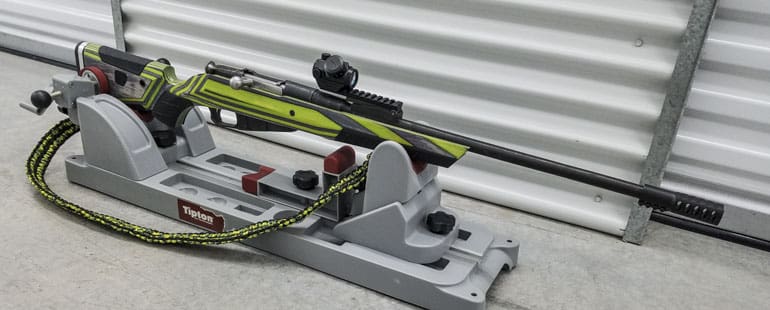
Here’s how I did it and what I learned along the way.
Planning and Components
Jeremy’s Mosin project gun is undoubtedly a beast with many cool features. But he had a number of steps performed by his professional gunsmith. The Prime Directive of my Mosin project was that there could be no operations that I could not do, or learn to do, myself. The Secondary Directive was that there would be no drilling and tapping of the barrel. While I have no fear of drilling and tapping, generally, I do not currently own a drill press; this makes properly placing and aligning the holes, and controlling their depth, somewhat dicey, at best.
Shortening the Barrel
The first and easiest decision was that the barrel was going to shed a few inches at the muzzle end. How much to cut off, though? Jeremy was looking for impressive muzzle flash and report, and that sounded great to me as objectives, too. Still, I wondered whether there was some objective way to decide exactly how much to shorten the barrel.
As it turns out, the answer is yes – sort of. In 2011, Brandon Louis Clark, then an enterprising student at the University of South Florida, earned his degree (at least in part, I hope) by publishing his honors thesis titled “Effect of Barrel Length on the Muzzle Velocity and Report from a Mosin-Nagant 7.62x54R Rifle” (Outstanding Honors Theses, Paper 8, 2011, http://scholarcommons.usf.edu/honors_et/8). Whether or not one agrees with Brandon’s “scientific methods,” his thesis idea was undeniably brilliant, and it definitely makes for some entertaining reading. Here is Brandon in his “laboratory” setup:
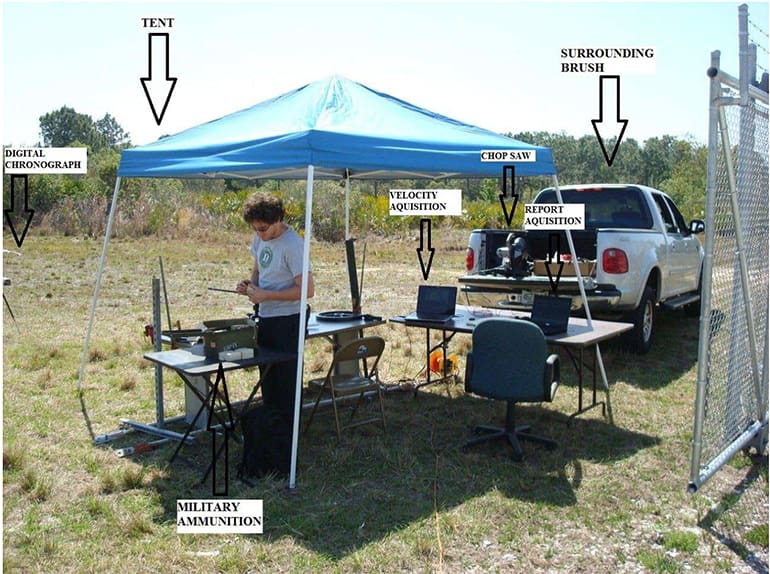
Attention to detail is important in science; note Brandon’s clever placement of “SURROUNDING BRUSH” for his testing. He doesn’t mention how well the rolling office desk chair worked out on the grassy field, but I digress – that wasn’t really the focus of his thesis, anyway.
Back to the matter of barrel length planning. While there were many flaws in Brandon’s experimental setup as well as limitations in his equipment that combined to prevent him from providing too much in the way of objectively repeatable measurements, his following observations jumped off the page:
As the barrel length decreased, audibly the differences became clear (even with earplugs). The report didn’t appear to become audibly intimidating until the final barrel cuts, most notably in the 18.75” and 16.75” barrel lengths. The muzzle blast also became quite intimidating at these lengths, no longer able to go unnoticed, whether firing in light or dark conditions.
Did I want truly “intimidating” noise and flash, something akin to firing the 16-inch guns of the USS Iowa? Probably not; at least if I wanted to be allowed to visit the local range again. Thus, I decided to exorcise only 9 inches of the 91/30’s 29-inch barrel; still close enough to “quite intimidating” for jazz.
Replacing the Stock & Trigger
Clearly, the most important thing to be done, after cutting down the barrel, was getting rid of the hideous Mosin-Nagant stock with its abominable steel buttplate. Fortunately, there are a number of aftermarket stocks made for the 91/30, including the highly popular ProMag Archangel stock that Jeremy S chose for his fun gun. I wasn’t looking for the tactical long-range look, however.
Instead, I had in mind an easily carried “scout” format pig gun. Again, there are plenty of stock options (sorry) in the “not tacti-cool” categories; in fact, there’s an almost infinite variety available from Boyds Gunstock Industries, Inc., alone. After many “do I like this one or that one” discussions between my ears, I chose the AT-ONE Mosin-Nagant wood stock in “ZOMBIE HUNTER LAMINATE,” that is, mostly lime green.
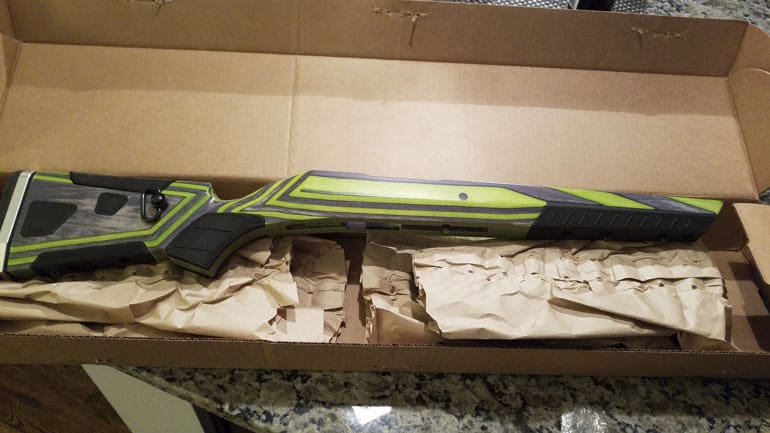
Among other useful features, the AT-ONE stock has the proprietary pushbutton BRING-IT adjustable comb and butt pad, single-point QD sling mount, interchangeable grip, and interchangeable fore-end.
When ordering the stock, I also opted for the version that would already be pre-inletted to accept the safety lever of the Timney #307 drop-in Mosin-Nagant trigger. I felt it was important to add a real external safety to this rifle, if I was ever going to actually carry it in the field. The Timney trigger uniformly gets rave reviews; replacing the Soviet’s-finest trigger group with the Timney #307 was a no-brainer.
Cost: Boyds AT-ONE stock pre-inlet for Timney #307 trigger, plus the Timney Mosin-Nagant #307 trigger, including tax and shipping: $300.75.
An Optic and the Problem of Mounting It
As should be clear, with the last nine inches of barrel coming off, so too would disappear the rifle’s front sight. Without drilling and tapping mounting holes in the barrel, I found only very limited options for mounting a new optic of any kind. I saw jury-rigged Airsoft Picatinny rails and a variety of other miscellaneous kluge jobs on the Internet (and on YouTube), none of which looked efficient, looked good, or in some cases even looked safe.
Ideally, I wanted to add a rail so that I could mount whatever optic I felt like mounting, and could change my mind later if I didn’t like what was mounted. Eventually, I came across a solid steel base and aluminum rail system made by Evolution Gun Works (or EGW). I know EGW makes good tough stuff, as I used their 1911 hard sear in a trigger job on my early 1928-made “Hartford Argentine Army” Model 1927 (one of the first 1911a1 pistols made by Colt for Argentina before turning over the production equipment after the first 10,000 were delivered).
The EGW rail/base part was designed to attach securely to the existing rear sight base already securely fixed to the rifle’s barrel. If the sight base was sturdy enough for Stalin, it was sturdy enough for me. I ordered it. This component became the focus of one of the major adventures of the project, as will be explained later.
Wanting to keep the total cost of this project at least reasonable, I decided to get another Bushnell TRS-25 red dot sight. I have this little rugged reliable red dot unit sitting atop a highly personalized AR-15 CQB rifle chambered in 5.56x45mm NATO, and it has never failed to impress me. At the currently absurd occasional street price of only $49, it is downright irresistible.
Cost: Bushnell TRS-25 Red Dot Optic – $49, no tax, free shipping; EGW HD Mosin Nagant 91/30 Picatinny Scope Mount 0 MOA, including tax and shipping – $97.74.
Adding a Muzzle Device
A brake was going to be a necessity. First, I wanted some relief from the otherwise sure-to-be hellish recoil (even with the butt pad of the Boyds stock), with the whole rifle weighing a pound or so less than before it was any fun at all to shoot. Second, a brake would accentuate the “sub-intimidating” (according to researcher Brandon Louis Clark) noise and muzzle flash of my newly cut-down 20-inch barrel, perhaps even elevating them into the “quite intimidating” zone.
Had I elected to engage the services of a professional gunsmith, I could have had the barrel’s new muzzle threaded with proper timing for a pre-selected muzzle device, as Jeremy did. That, however, would have violated the Prime Directive (“Do Not Make Contact With A Professional Gunsmith For This Project”). Thus, I looked for clamp-on options.
My research led me to the custom-made Clamp On Muzzle Brake offered by Witt Machine & Tool Co., about which I read great things (by anyone skilled enough to make two precise barrel diameter measurements required for proper fit). After finishing work on the barrel, I made the necessary measurements and placed my order for a Graphite Black Cerakote brake.

Cost: Witt Machine Clamp On Muzzle Brake (MB1), 7.62x54R, Brake Finish Graphite Black Cerakote, including tax and shipping: $112.40.
Tools
For most of the job, precious few tools are needed. As anyone who has ever owned a Mosin-Nagant knows, the entire rifle has about twelve parts and can be completely disassembled with nothing more than the bayonet. Only a few new tools would be needed for this project, namely, the Pacific Tool & Gauge barrel crowning and chamfering cutters (with pilot and handle), and a brass lapping tool to de-burr the finished chamfer. Apart from that, everything else was already in the shop. Here is the complete list of tools I used to do the job:
Screwdrivers (in lieu of the 91/30 bayonet tip)
3 Bar clamps
Hack saw with new 24 TPI blade
Viper’s Venom Heavy-Duty Cutting Oil (any high-sulfur cutting oil will do)
PTG Interchangeable Pilot Muzzle Chamfering and Crowning Cutter Handle
PTG Interchangeable Pilot for Muzzle Chamfering/Crowning Cutters – .30 Caliber
PTG 90° Crowning Cutter 1″ Diameter
PTG 45° Chamfering/Crowning Cutter – 1/2″ Diameter
Brass muzzle lapping kit from East Ridge Gun Co. Inc. (eBay seller), including 600-grit SiO2 lapping paste
Brass gunsmith’s hammer
Pin punch
Hex keys
Dremel rotary tool with various bits for wood shaping
Precision caliper
600-grit emery cloth
Blue LOCTITE® threadlocker
All in all, not much of an investment in tools was needed, and none that I can’t use again for other projects on different guns. What it will actually cost someone to do a similar project depends on how well that someone’s shop is already equipped with tools. The PTG barrel tools plus the cutting oil, tax and shipping included, cost me $109.15. Additional pilots in other calibers for the 90-degree cutting and 45-degree chamfering tools cost $25 each. The brass lapping kit costs $6.75 (free shipping) on eBay and comes with enough silicon dioxide lapping paste to last a lifetime of projects.
Doing the Job, Surprises, and Victory!
After making sure that the rifle was unloaded, I removed the bolt and disassembled the gun, removing and throwing away all wood stock parts. The rear sight blade and spring were removed by driving out the forward hinge pin. Once the entire trigger group was removed, I was left with a barreled action.
A preliminary word about this rifle, and many 91/30’s, is in order. When I first acquired it, there was a rough pit in the rear right-hand side of the chamber. Many Mosin-Nagant rifles have squirrelly chambers to one degree of nastiness or another, the result of corrosive ammo and poor (or no) cleaning by its comrade possessor(s) during WW2. The pit in mine, although shallow, had a sharp burr at its rearmost edge.
When a steel case 7.62x54R round was chambered and fired, the steel wall of the shell case would expand into this pit and get locked in place by the burr. Opening the bolt required several sharp raps with a mallet, jokingly referred to as a standard issue Soviet Red Army tool. It became so annoying, and earned me a sufficiently large number of at least curious glances at the range when I went at my rifle with a large black rubber mallet after each shot, that I had already fixed it a couple of years ago.
There are professional ways to clean up and polish a rough chamber, using professional chamber cleaning-up and polishing tools. I didn’t choose that path. Instead, there are lots of totally plausible ways to do the job “As Seen On TV,” or at least as seen on YouTube.
I spent some time and energy removing the burr and polishing out the pit by doing the following steps, in order: (1) spinning strips of 320 grit emery paper fixed to the slotted end of a wood dowel with my cordless drill until the burr was definitely gone, then (2) spinning 0000 steel wool spun onto the same wood dowel until the pit felt quite smooth to the touch and, finally, (3) spinning a section of ScotchBrite scrub pad slathered liberally and repeatedly with SoftScrub cleaning liquid, which is mildly abrasive, until the chamber was actually highly polished.
On the next trip to the range, the bolt had no trouble smoothly and easily extracting milsurp steel case ammo. I should say that the problem was never quite as bad an issue with more expensive and higher quality brass-cased ammo, the brass being much more resilient than the steel. But isn’t much of the fun of shooting a Mosin-Nagant knowing how little you paid for an old-fashioned spam can of Iron Curtain steel case milsurp 7.62x54R ammo?
Back to the Zombie Hunter Mosin-to-Pig-Gun conversion project, the first order of business was shortening the barrel. Again, it was YouTube to the rescue. Any number of DIY videos demonstrate how to do this, some without even using proper cutting tools. I used the right tools for the job, including – a hacksaw with a new blade.
It might seem odd that the barrel is simply cut down to the desired length with an ordinary hacksaw kept well-lubricated with cutting oil, but as a matter of fact it is just that simple. Hardened steel clamp-on jigs for keeping the saw blade perpendicular to the bore are available, but seem completely unnecessary when the PTG 90-degree cutting tool will be used to true the crown after the hacksaw does its job. As for hacksaw blade selection, I like the smoother cutting action of a 24 TPI blade, despite the fact that it cuts a bit more slowly than an 18 TPI blade. For a job as small as this one, speed of cutting was not any concern at all.
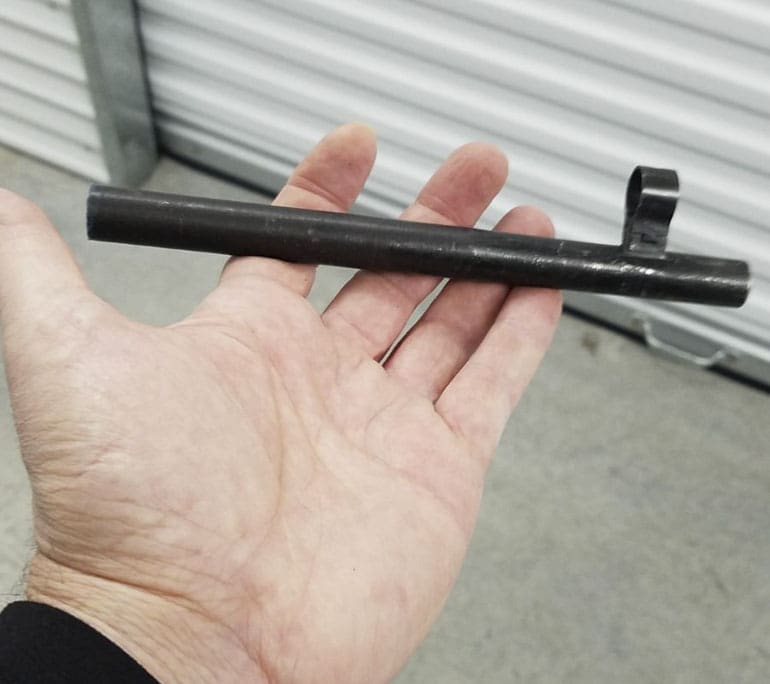
I also have to say that there is something curiously satisfying about cutting off 9 inches of the barrel with a hacksaw.
The 90-degree crowning cutter, the 45-degree chamfer cutter, and the brass lapping tool could hardly be easier to use, the first two with generously applied cutting oil and the third with 600-grit silicon dioxide lapping paste. After trueing the crown and cutting the small chamfer, some elbow grease and emery cloth was used to remove any chatter marks left behind by the 90-degree cutter.
In fact, I found it impossible to avoid making chatter marks with the 4-blade PTG 90-degree cutter; there are cutters having many more blades which supposedly eliminate or at least substantially reduce chatter, but those cutters are truly expensive and definitely unjustifiable for this project.
The whole barrel shortening operation didn’t take even 30 minutes, if that. Once I was happy with the new crown, I used my caliper to take the two barrel diameter measurements (to the thousandth of an inch) needed to order the custom clamp-on muzzle brake from Witt Machine, and then placed that order.
The next steps were to install the Timney trigger in the action, and then install the action in the Boyds AT-ONE stock. The first step couldn’t be simpler; the second, not so much, to my surprise. When I laid the action in the stock, I discovered that the while the through holes in the stock for receiving the rear guard tang screw and the front guard screw were properly spaced apart, the well for receiving the threaded recoil lug on the barrel for the front screw (in which the front through hole is located) was positioned a few millimeters too far forward.
The resulting interference caused the entire action to sit a few millimeters too far forward and, thus, made it impossible to start the screws in their respective threaded holes. This is one more reason why Mankind was given Dremel tools. A few minutes of making sawdust and the misalignment issue was resolved.
Once the recoil lug location issue was solved, the barreled action initially fit very tightly in the AT-ONE stock, so tightly that I couldn’t get the mated parts close enough to start the aforementioned screws. I had two options: sand the high spots on the inside of the stock, or press fit the action into the stock using bar clamps. I did both. Issue solved with slight effort.
Given the ultimate intended use of this “new” rifle, I saw no need for glass bedding or any other mechanical connection between the action and stock beyond the original designers’ two screws. On the whole, installation of the barreled action with the Timney trigger into the AT-ONE stock was fundamentally simple but required a bit more tinkering than I had expected. No task was too difficult or too time-consuming, but “drop-in” would not be an accurate word to describe the installation process.
The next task, installing the EGW mount and rail, turned out to be the most interesting part of the job. The item is beefy, comprising a hardened steel base and an aluminum rail that attaches to the base:
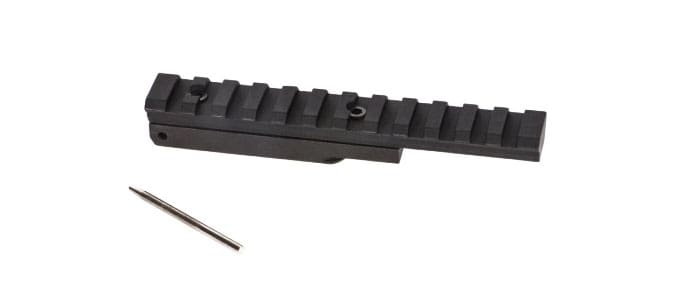
When I looked for reviews, YouTube videos, or any other information about EGW’s part, there was absolutely nothing to be found. That’s unusual, in my experience. I bought it anyway, on faith that EGW made good stuff. But when I tried to install the steel base piece into the existing rear sight base of the rifle, it didn’t fit right.
Was there a reason I couldn’t find anything about it? I took out my trusty Dremel tool and cleaned up the rough inside of the painted steel sight base – after all, it was made during wartime somewhere in Russia. I re-blued any bare steel caused by the tool. Still no go – and clearly the problem was not merely an issue of surface fit. Did my Mosin-Nagant 91/30 not have a standard rear sight? Investigation was needed.
It turns out that there are at least two different rear sight bases found on 91/30s, as is clearly explained by 7.62x54r.net at http://www.7.62x54r.net/MosinID/MosinFeatures02.htm. It also turns out that EGW did not realize this and designed its sight base to fit the Tula factory’s “set screw and solder attachment” version which was used there continuously throughout the war.
As 7.62x54r.net’s photos show, engineers at the Izhevsk factory devised a modified “dovetail and two pin attachment” system in 1940, which was easier to manufacture and eliminated a soldering step during assembly of the rifle. This new arrangement required forming a taller boss on top of the barrel in order to provide sufficient metal for the two lateral pins to pass through. The step and two pins are seen in these photos:

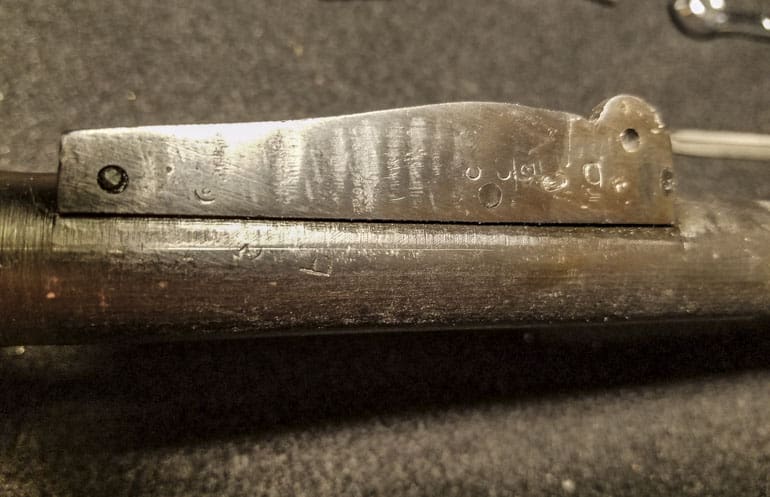
The step on top of the boss is not seen in Tula-produced rifles (so I am told, though I have not inspected one myself since doing this project). Most 91/30s that were refurbished at any point after initial manufacture were modified to use the “dovetail and two pin” setup, according to 7.62x54r.net.
EGW’s Mosin-Nagant sight base/rail—a new product for the company—was apparently designed for the Tula version of the rear sight base, without realization of the differences in the later Izhevsk version. The flat bottom of the EGW base piece did not clear the step of the mounting boss supporting the Izhevsk version on top of the barrel. My rifle was made at the Izhevsk factory in 1942. The mystery of why the brand-new part didn’t fit was solved, but there was no easy solution to this problem that I could do myself, for at least three reasons.
First, because EGW’s steel base piece is made of hardened steel, accurately removing so much material with my Dremel tool was going to be at least challenging, and might even render the part unusable. Second, I couldn’t remove material from the boss to smooth out the step without exposing the attachment pin. Third, I couldn’t get professional gunsmith help without violating the Prime Directive. So I contacted George (“Geo”) Smith, President of EGW, explained the issue, sent photos, drawings, and measurements, and sent back the chunk of hardened steel that his good people had sent to me.
The simple plan we discussed was to judiciously remove enough hardened steel from the underside of the hardened steel base part so that it would clear the step of the barrel boss. More importantly, since this change involved only removal of material, the resulting piece would be universal for virtually all 91/30s regardless of which factory they came out of, or when. Here are “before” and “after” pictures of the steel base part:
Before (notice the flat bottom parallel to the top surface):

After:
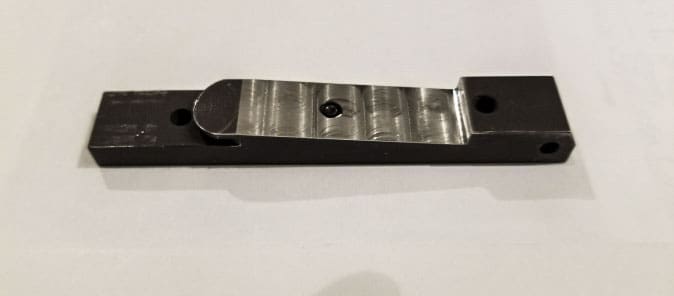
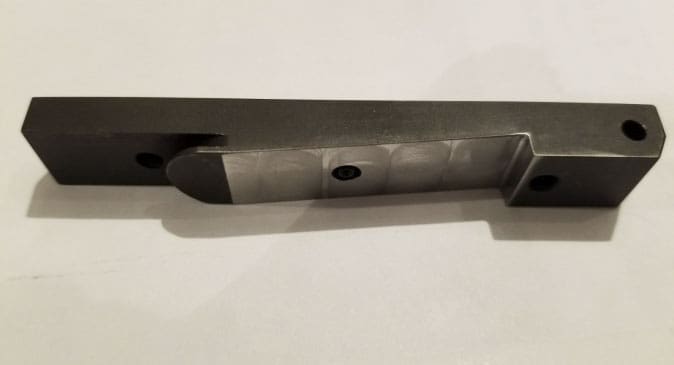
The base piece is designed to fit very tightly into the Mosin’s existing sight base, to eliminate any play after installation. To ease installation, I used the Dremel tool to slightly chamfer all of the hard edges around the bottom of the part, and then tapped it into place while taking care to align the lateral through-hole with the existing holes in the sight base. The original mounting pin was lightly chamfered at one end and then driven into place. The central set screw was tightened down and secured with Blue LOCTITE™ threadlocker and the Picatinny rail section was attached with its two provided hex head cap screws, similarly locked in place with threadlocker.
The EGW part fits my rifle perfectly. The design is clever and the parts are as strong as can be imagined. This is the simplest, strongest, and most elegant solution for adding a Picatinny rail to a Mosin-Nagant 91/30 rifle, short of drilling and tapping the barrel. Here is the fully-installed rail with the Bushnell TRS-25 red dot optic mounted:

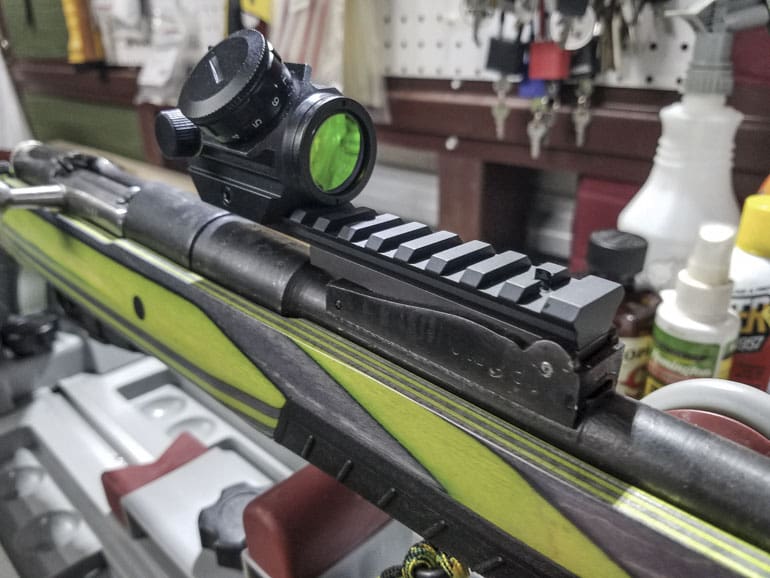
Now, some readers may think I’m some sort of hypocrite, having violated the Prime Directive for this project with respect to my dealing with the misbehaving EGW part. I do not consider discussing the technical issues with, and getting real machine shop help from, EGW’s President to constitute impermissible Making Contact With A Professional Gunsmith, notwithstanding the fact that Geo Smith is most assuredly a Professional Gunsmith of the highest order. He’s just the guy I bought the part from, and I was making a warranty claim!
By the way, look up Geo Smith on the Internet and you’ll read many comments in various forums about his well-deserved excellent reputation for quality, fair dealing, and customer service. I was already a satisfied EGW customer before doing this project; now I’m practically a shill for the company and its President.
When the Witt Machine muzzle brake arrived, mounting it on the barrel could not have been easier. Blue LOCTITE is used as both threadlocker and lubricant, as the custom-machined brake fit quite snugly on the end of the barrel, before tightening the four hex screws to about 15 in-lbs. torque. A thing of intimidating beauty, in my opinion:
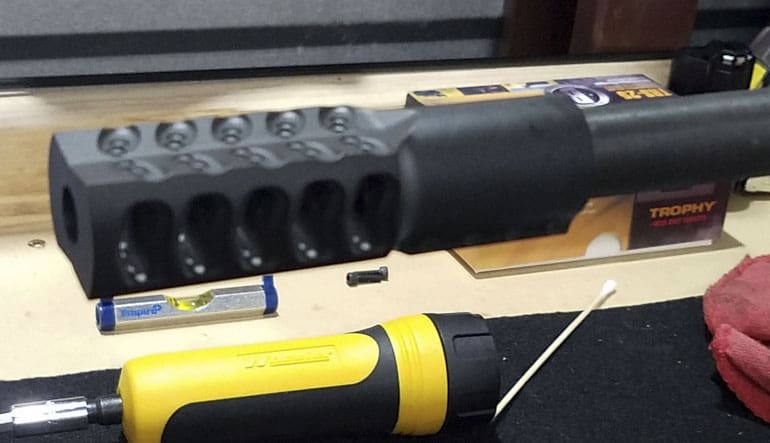
One More Thing – the Sling
I wanted to find a nice sling that would complement the Boyds ZOMBIE HUNTER LAMINATE color scheme in combination with the basic black metal parts of the rifle (apart from the distinctive in-the-white 91/30 bolt). Searching high and low as I did, and in-between, too, yielded nothing even close to what I had in mind. But while I was looking, I came across a number of rifle slings woven from 550 paracord in various colors. A quick search of YouTube revealed some “how-to DIY” videos by regular guys making paracord slings, plus a bunch of how-to DIY videos by 20-something stoners making paracord slings.
I figured that if stoners could do it, I could do it – and I figured correctly. I bought the necessary lengths of appropriately colored 550 paracord at Walmart, found a pair of Uncle Mike’s rifle sling swivels in my workshop’s Magic Bin Of Spare Gun Parts That I Might Need Someday, learned how to weave the basic cobra stitch, and made my own matching ZOMBIE HUNTER LAMINATE color scheme sling, which turned out perfectly:
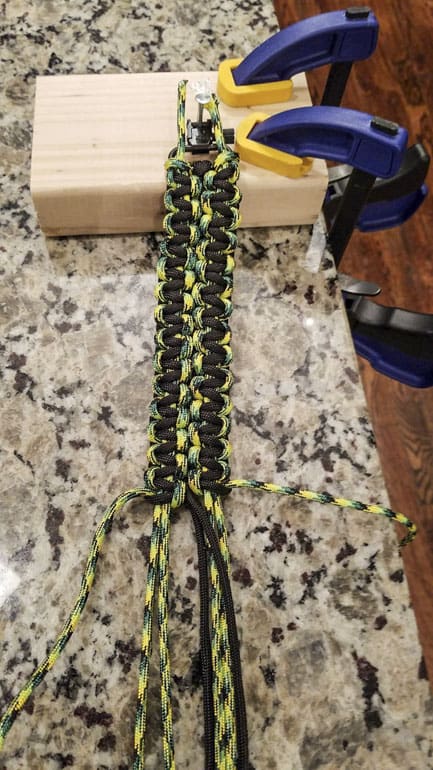
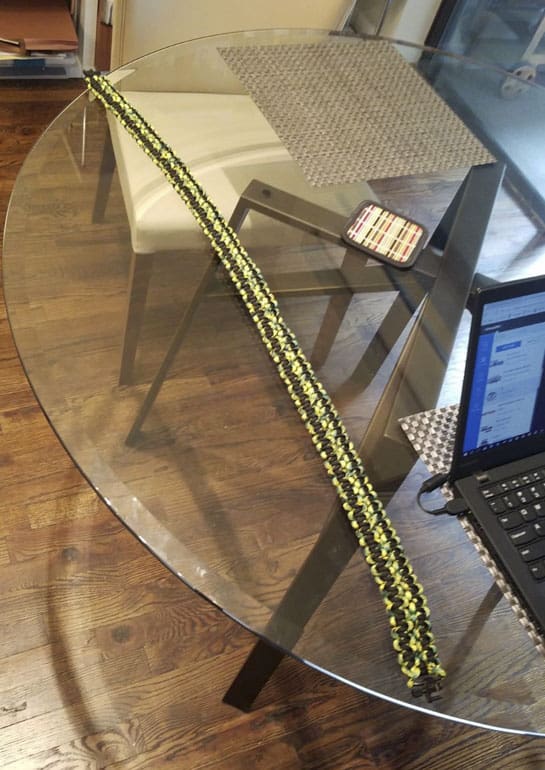
It took about four hours, probably an hour longer than it would have taken had I ever made a woven paracord anything before. And I didn’t need to be stoned to do it. Apparently.
Cost: 550 paracord, 100 feet each of black and green camo colors: $12 at Walmart; Uncle Mike’s rifle sling swivel set: about $10 (though this ten-spot was spent at some indeterminate time in the past).
Conclusion
How did it turn out? Pretty great, I think. Just for nostalgia’s sake, here are the “before” and “after” pics:


The total cost of parts was about $580, plus I spent approximately another $115 on new tools for my workshop. Some might say “Peter, for the same $700 you could have bought a very nice used or even brand new hunting rifle.” While that may be true, other people could buy that very same rifle. No one else but me owns THIS custom Mosin-Nagant pig gun, nor one exactly like it, at least to the best of my knowledge and belief. Plus, I can rest easier knowing that my old beat-up Soviet bolt-action battle rifle isn’t being used as a gardening implement.
Most importantly, planning and doing this project was JUST PLAIN FUN, and I learned a thing or do in the process. There’s not another gun of mine that I would have been willing to take a hacksaw to as a first-timer at barrel shortening.
Having done it, though, and having experienced for myself how easy it is to cut and re-crown a barrel, I would do it again – or at least re-crown and chamfer — without hesitation, should I somehow damage the crown of another one of my rifles. And take another look at the end result – need I say more? This scout gun rocks! I cannot wait to make some “quite intimidating” noise and muzzle flash at the range, and then maybe shoot a hog that’s already stopped in its tracks to admire my handiwork.

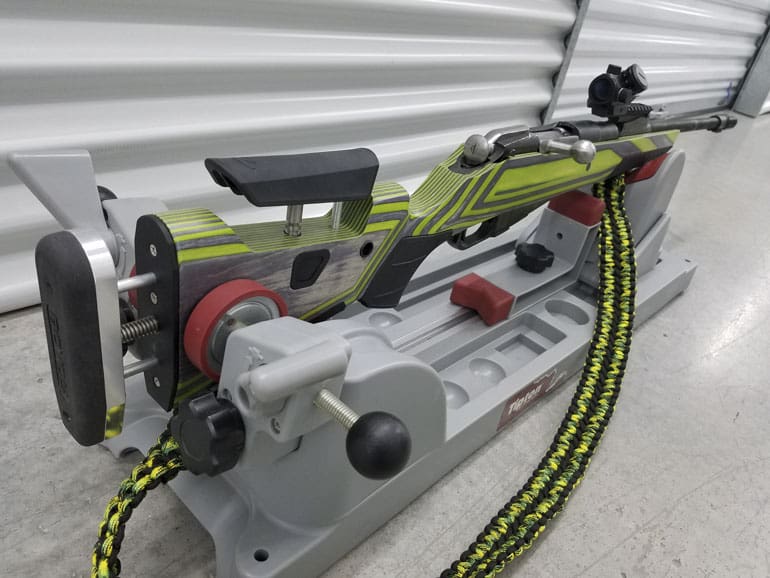



Hot. Garbage.
Good luck keeping it fed.
Cases of PPU are about as cheap as you can get and if you’re going to do that, might as well feed an AR.
Good article. I like a good DIY story. I hope we get a range report follow-up.
“I hope we get a range report follow-up.”
I second this request!
And I want to know how accurate it is with cheap military surplus as well as nice, modern brass cased factory ammunition.
Oh, and chronograph results would also be helpful: I want to know what muzzle velocity to expect with a shorter barrel.
Zombie Nazi Apocalypse.
Dead Snow.
oh, sure. but did you see the sequel?
This is what happens when guys get bored.
We fiddle fuck with things. Sometimes for good. Sometimes, not.
“If it ain’t broke, you can probably still fix it.”
-Tim Allen
Outstanding.
An absolute abomination. I applaud you sir.
Cool project, willing to part with the chunk of Mosin barrel for a decent price? Wanting a piece for a project.
I too love a good DIY project. Thanx.
I’ve found that using a well made copper pipe cutter and two turns, tighten, two turns tighten works so much better then a hacksaw. All the hard work of keeping the blade straight is eliminated, and if you put the big wheel of the pipe cutter towards the barrel that stays, and go slow, you can’t even see where the wheel turned. I used to use a chop saw but finishing the crown took longer then taking time with the pipe cutter. …. Me I’d have kept the long barrel for the added velocity….. Also I’ve had trouble keeping those clamp on muzzle brakes from working loose, so I don’t use those any more, plus they seem to fuck up the harmonics of the barrel and string my shots. That’s a cool rifle you built there, have some fun with it. How to say “,Die pig die” in Russian is your next step 😉
(1) I cannot believe that a copper pipe cutter blade is hard enough to cut through a steel rifle barrel.
(2) How do you stop the copper pipe cutter from wandering/spiraling on a tapered barrel?
I have…several…MNs that no longer look like what they did. Some are VERY pretty, a couple are truly fugly, but cost nearly nothing to buy and convert to their new mission. They provided MANY hours of fun/joy hacking, slashing, grinding, shaping, fabricating, abandoning, starting over, etc.
The was back when i was buying 91/30s for $100 or less. No more. I haven’t seen even a common beater at a show for under $250 in years. The parts are drying up as well. Too much money to carve them up. Sad. I miss it.
I have another idea cooking, and I have a friend who has “too many” MNs. I’ll see if he wants to part with one for a reasonable price.
Good thing I stocked up and spam tins years ago. Ammo prices have gone through the roof as well.
Exactly why I don’t have a Mosin. Prices are stupid now for the firearm and the ammo. I’ve thought many times “wish I was this into firearms 15-20 years ago when Russian surplus firearms and ammo were actually cheap”
Nice job and rifle, good post.
Awesome.
I used to buy Mosins by the crate, back when they were $60 a piece when you bought the crate. I’ve done just about everything you can do to them. They are what I learned to smith on. I even cut down a tree and carved a mulberry stock for one once. It actually came out quite nice.
But when it comes to the accuracy of these rifles, I found that they were often much more accurate than people gave them credit for, and I found many that were MOA guns without significant modification.
The bores measure anywhere from .310 to .314. You’ll have to slug the bore to figure out what it really measures at. When you do, get the appropriate sized bullet and reload your own ammunition. You will likely be shocked what the rifle can do when an undersized bullet isn’t wobbling down the barrel. They all also seem to like a heavy for caliber round, as well as a round nosed bullet. I still have a few that slugged .311. I load them with a 180gr round nosed British .303 bullet (.311 diameter) and they shoot great when pushed right at 2500fps.
Reminds me I want to carve another stock for one.
Still mad at my wife for vetoing a crate of Mosins back when they were in that $60 to $70 ea delivered in crate price range. I wanted to make a sweet coffee table out of it as some people have with glass on top so you can see down into the rifles and accessories and have it softly lighted internally. Plus as an investment. Which, on the bright side, is something I can “told you so” to her now that the value would be a good 4x what it would have cost me hahaha
Ha! Same thing happened to me.
“You want to buy a CRATE of rifles?!”
I didn’t push back very hard, as the idea sounded a bit out there, even to me, despite the fact that I was sure they were going to increase in value a lot in a short amount of time.
Bubba, no!
This ensemble will not be complete until you get a Z Hunter knife!
https://youtu.be/Wqjjdcrkswc
So, um, after all that, how does it shoot?
Instead shooting like crap, now it shoots like an expensive piece of crap. Lol. I’ve had 3 at one point or another and got rid of them all.
I’ve read the forums, done the mods, and they still suck! Kinda neat though still. It’s just sad though how enthusiasts downright need to believe that they are sometimes sub-moa rifles. No one has ever posted proof through standard accuracy testing.
I could have warned you about the rear sight mishegoss, and also about needing the Dremel to fit the stock. WW2 Russian gunmakers never met a standard that they didn’t like breaking.
Cutting 9″ off the muzzle converted a rifle to a carbine, as the length of your project gun barrel is now about the same as a M38 or M44 carbine. As I own a couple of said carbeasts (as well as a Boyd re-stocked 91/30), I can testify to the loudness of their report and their blinding muzzle flash.
Be aware that M91/30 was designed to be fired with the cruciform bayonet attached, since the guns were zeroed that way at 300 yards. Without the bayonet, most 91/30s tend to shoot high at 100 yards and the windage will be off as well.
The difference between shooting with and without the bayonet can change the POI by as much as seven or eight inches.
But, 91/30 owners, do not force fit the bayonet. It can be really hard to remove and it usually leaves a mark.
Welp, there it is, the worst thing I’ve seen on the internet today. You get an E for effort.
I give this Idiot the Moron Award of the 21st Century. You can always count on an ignorant hill jack to destroy and annihilate every weapon he gets his hands on. So this Jerk spent $700 which was $700 right down the drain and he destroyed a historic military rifle to boot. This nut case does not even realize that just in the last few years Mosin rifles went from $60 a piece to as high as $400 and much of this was due to the fact that Nato was ordered to destroy military weapons that are no longer in use to prevent them from being sold to civilians. The untouched original rifles will continue to go up in value while his fked up abortion is worth less than scrap value at a junk yard.
Remember this is nothing new as in the 50’s and 60’s the Hill Jack Morons even cut up original sniper rifles and made them into “deer rifles” and ditto for Czech Mountain rifles. Both weapons in original condition now sell for thousands while the hill jacked abortion specials are not even worth scrape iron prices.
You would think as time went on Jethro Bodine and his brother the author just might of learned something about collecting military rifles but no they are as ignorant today as they were in the 50’s and 60’s. With guys like this we do not need anti-gun people as the hill jacks will destroy all the guns for us.
Typical soros nazi. Get all bent out of shape by what a man does with his private property.
Relax. It’s just a garbage rod. Don’t care if people use them for tent poles. Not like they butchered up some K98’s or Garands. Geez.
I guThe only reason to keep Mosins around is as a warning to future generations.
What it’s worth to you isn’t important. What’s it’s worth to him is.
Grow up.
I know right, it’s super hard to find 03’s that haven’t been messed with, Enfield’s are even worse. You should restain your name calling IMHO however, because it does anger some people, Crisco Kid
Agree,
Look, its not that you can’t do things with your own property, its just that sometimes its not the best idea.
Any way you look at it, its destroying history.
Running “range powder” through an arisaka trying to break it to prove its strong, like it hasn’t been done before, or putting smokeless powder in an original 1851 revolver to see just how strong they were built.
Yea, its possible to do, but these originals will never be made again. Yes at one time there were cases upon cases of them cheap and plentiful, but not any more.
Valuing a zombie gun over a WW2 relic is why we have kids eating Tide pods and chanting to repeal the 2nd amendment, all of history is important, not just pieces cherry picked.
Side note, if he wouldn’t have cut the barrel he could of saved all the pieces and swapped back over later after the fun was done as this was basically snapped together.
JMHO
Did a 91/30 diy conversion as a father and teenage son project a few years ago. We did drill and tap the receiver. We had a blast doing it and he ended up with a great hunting rifle that shoots moa, even though he was under 21 years old. For both of us, what we got out of it was worth far more than any financial appreciation than the rifle will ever see. Some folks just can’t understand this-so, they can put the ‘r’ back in ‘cisco’, and lube up for more verbal masturbation.
As an actual real life TV Zombie, I really wish you folks would lighten up on the Zombie gun thing.
I mean….if it saves just one Zombie!
Another historic firearm destroyed. Before you know it there’ll be only 30 million of these left.
A few more years they’ll be over 100 years old.
30 million shared with 7.6 billion people, maybe 10 years from now there will only be 20 million to share with 10 billion people…..
It’s ok, our grandkids can just google pictures of them, its like… the same man…
Re copper tubing cutters: There are steel-tubing cutters which look just like the copper-cutting versions. They have stronger and thicker steel in their blades. If you want to try to do some barrel-cutting with that kind of a tool, you’d do well to make sure you get that version of it.
I wouldn’t have taken on this particular DIY job, but the writer, Peter C. Schechter, teaches people some very good pointers about DIY gunsmithing, and those pointers can help us all when we work on other firearms. He’s also a very good communicator and teacher, and I admire him for those qualities.
You Sir are crazy. I salute you.
Now I need to dig mine out from the back of one of the safes. I bought mine when they were $60.
It may not be as cheap, but replace that Bushnell with a Holosun with a solar panel; will last in the zombie apocolypse better when you can’t get CR-2032’s.
When it comes to ignorant Hill Jacks they do not realize that NO YOU DO NOT OWN ANYTHING, YOU ARE ONLY TEMPORARY CARETAKER OF IT. Because when the world finally is a better off world when you kick off the fact remains you have destroyed a historic military rifle that future generations will never again be able to appreciate or even know what they even looked like.
Yes an ignorant Hill Jack has always been his own worst enemy and has destroyed more historic guns than the anti-gunners could ever dream about doing. The Anti-gunners thank all you Morons out there that have done so much to destroy the world heritage of military firearms because when a firearm no longer has any historical value its much easier to pass laws to melt what is left down into scrap steel.
All that work, and its still a Mosin.
Absolutely barbaric.
Comments are closed.